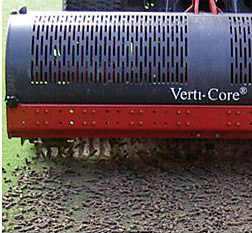Compaction
Areas that receive a lot of traffic usually become compacted. The traffic may be foot, hoof or tire, but results are still the same. Soil particles are packed closer together creating a root zone where there is little air, poor percolation of water and a tough medium for roots to grow in. Roots respond to compacted soil with less growth and development, creating a thin and shallow root system. Stands of turf on compacted soils are generally thin, exhibit stress symptoms more readily and have poor regrowth and recovery from wear.

Soils in gardens and beds can be deeply tilled to break up this compaction. Turf stands are rarely torn up this much, so other means are in order for lawns and sports turf. The most effective form of relief for a compacted lawn is core aeration, this process, a machine with hollow tines pulls soil cores from the turf to soften the soil and allow roots, air and water to penetrate deeper. These holes are generally 3 to 4 inches deep and the diameter of your finger. To keep these holes open for more than a month, a top dressing of about ¼ to ½ inch of sand is often applied and brushed or dragged into the sod and core holes.
